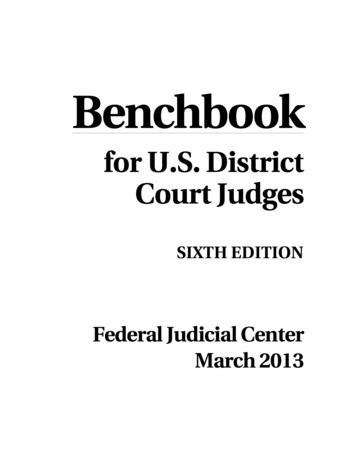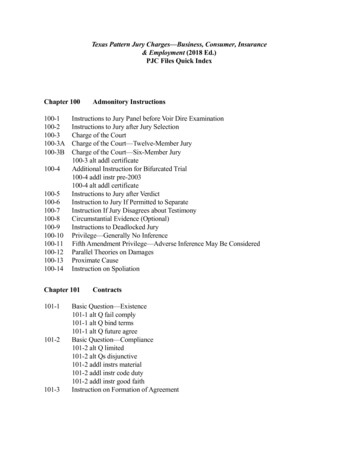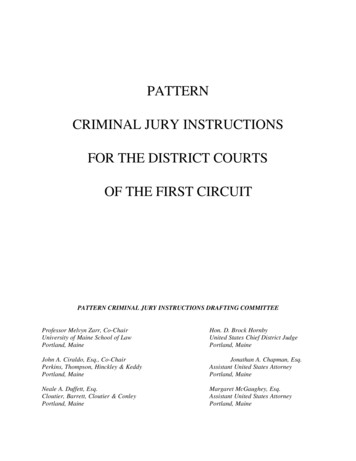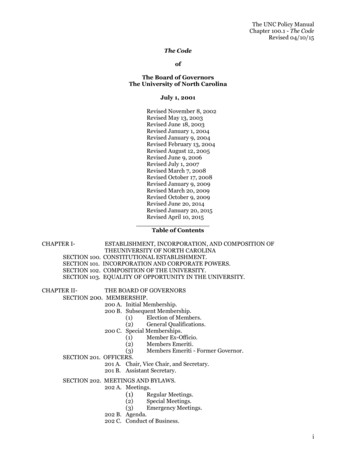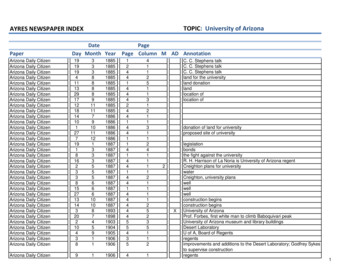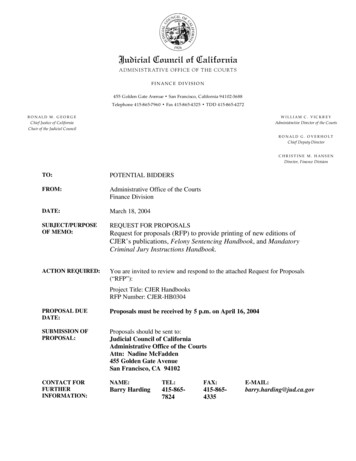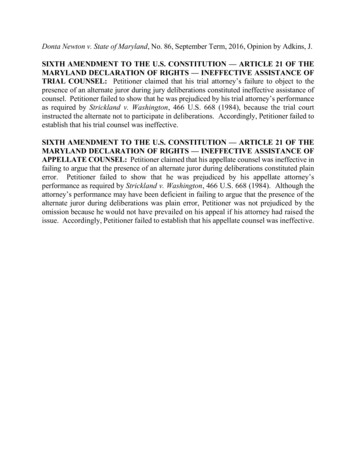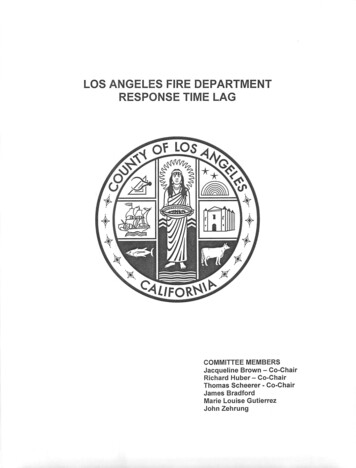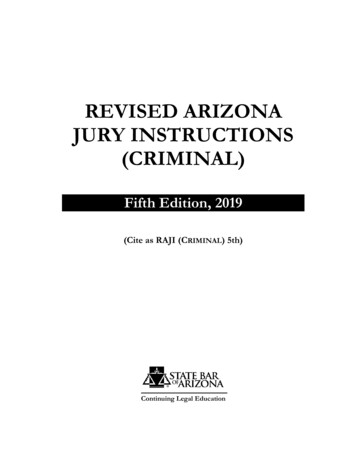
Transcription
REVISED ARIZONAJURY INSTRUCTIONS(CRIMINAL)Fifth Edition, 2019(Cite as RAJI (CRIMINAL) 5th)Continuing Legal Education
Copyright 1989, 1996, 2000, 2008, 2010–2019Third Edition – 20082010 Supplement April 20102011 Cumulative Supplement – June 20112012 Cumulative Supplement – June 2012Third Edition –December 2013Fourth Edition – December 20162017 Update – March 20172018 Update – July 2018Fifth Edition – September 2019State Bar of ArizonaAll Rights Reserved.Library of Congress Number Applied for.Printed in the United States of AmericaRAJI (CRIMINAL) 5TH has been prepared by the Criminal Jury InstructionsCommittee of the State Bar of Arizona. The State Bar Board of Governors hasapproved these instructions and authorized their publication and sale.These instructions are recommended for use in all criminal trials in Arizona courts.But court and counsel should satisfy themselves in each case—from original andfully current authority—that the instructions being given in a case are bothappropriate and correct for the case.With regard to the use of these instructions, please refer to the Important Noticeimmediately following.
PREFACEThis Fifth Edition, and prior editions, of REVISED CRIMINAL JURY INSTRUCTIONS (RAJICRIMINAL) is the product of thousands of hours of work by the State Bar of Arizona CriminalJury Instruction Committee. This project would not have been accomplished without thededicated work of the members of the Criminal Jury Instruction Committee. RAJI CRIMINAL,5TH EDITION represents a collaborative effort by defense attorneys, prosecutors and judicialofficers.The First Edition of RAJI CRIMINAL was published in 1989 as RECOMMENDED ARIZONAJURY INSTRUCTIONS. Those jury instructions were approved in advance of publication by theArizona Supreme Court. Subsequently, the Arizona Supreme Court stopped approving juryinstructions except in the context of appellate cases. Accordingly, the user is advised that theseinstructions have not been approved by the Arizona Supreme Court.The Second Edition of RAJI CRIMINAL was published in 1996 under the renamed titleREVISED ARIZONA JURY INSTRUCTIONS (CRIMINAL), 2nd Edition. After publication of the 1996RAJIs, the Criminal Jury Instruction Committee was assigned the task of revising theinstructions. A supplement was published in 2000. From 1997 to 2005, the Committeecompleted the Standard Instructions, eight chapters in Title 13, Title 28 instructions and noncapital case aggravation phase instructions. Work on the capital case instructions started in 2002following the United State Supreme Court’s decision in Ring v. Arizona. Since 2005, theCommittee completed over twenty-five chapters in Title 13 and four non-Title 13 chapters,revamped Title 28 (predominantly DUI instructions) and drafted the capital case instructions,amounting to over 400 individual instructions and verdict forms. A large bulk of theseinstructions, including all the capital case instructions, did not even exist in the 1996 RAJICRIMINAL, 2nd Edition.The Third Edition, published in 2008, represented a comprehensive revision to RAJICRIMINAL, 2nd Edition and its supplements. Subsequent editions include revisions based onyearly legislative amendments to the Arizona Criminal Code.Many of the jury instructions are accompanied by Use Notes and Comments. The CriminalJury Instruction Committee not only wants RAJI CRIMINAL, 5th Edition to be a comprehensiveset of accurate jury instructions, but also a resource for the user wishing to do additionalresearch about issues related to criminal jury instructions.We thank the past and present members of the Committee for their hard work in bringingthe third edition to fruition. We also thank Ilona Kukan from the State Bar staff for herassistance and encouragement. The instructions remain a work in progress, so any suggestionsfor revisions or for new instructions are always appreciated. The State Bar is committed tokeeping RAJI Criminal up-to-date with periodic supplements reflecting legislative changes andthe always evolving case law.Hon. Sam J. Myers, ChairJune 2019
State Bar of ArizonaCriminal Jury Instructions Committee Members1999-2019Hon. Gary E. Donahoe, Chair (04-11)Antonio R. Zúñiga, Chair (02-03)Hon. James H. Keppel, Chair (98-02)Hon. Paul J. McMurdie, Chair (11-13)Hon. Sam J. Myers, Chair (15-19)Lisa M. Aubuchon (00-10)Hon. Jay R. Adleman (12-15)Jennifer S. Bedier (05-06)James P. Beene (03-15)Matthew H. Binford (12-18)Elizabeth T. Bingert (16-19Hon. James G. Blake (96-01)Michael V. Black (11-13)Jocquese L. Blackwell (08-11)Lawrence H. Blieden (08-14)Michael A. Breeze (18-21)Hon. Maria C. Brewer (12-19)Brandon M. Brown (14-17)Sean H. Bruner (98-02)Hon. Douglas R. Camacho (15-18)Theodore Campagnolo (99-13)Flynn P. Carey (11-13)C. Daniel Carrion (96-19)Kent E. Cattani (06-12)Bruce H. Chalk (09-19)Joel Chorny 915-1James P. Cleary (00-03)Edwin M. Cook (99-01)Sylvina D. Cotto (99-01)William B. DeMars, Jr. (04-10)David G. Derickson (13-14)Hon. Gary E. Donahoe (02-08)Hon. Sally Schneider Duncan (04-13)David J. Euchner (10-19)Hon. John M. Gaylord (02-03)Stacey F. Gottlieb (97-01)Robert K. Gundacker (11-17)Hon. Philip Hall (99)Paul W. Hawkins (16-19)Hon. Ruth Hilliard (99)Melissa Ho (07-13)Hon. Jason R. Holmberg (18-19Robb P. Holmes (05-19)Jeremy D. Horn (14-17)Hon. Jeffrey A. Hotham (98-01)Joan N. Huls (98-01)Patience Huntwork (99)Hon. Brian K. Ishikawa (98-01)Shawn A. Jensvold (10-13)Alice M. Jones (18-19)Monica B. Klapper (10-13)Hon. Roger Kaufman (00)Hon. John N. Lamb (05-17)Todd C. Lawson (11-19)Vikki M. Liles (13-16)Jennifer K. Linn (16-19)Hon. Danelle B. Liwski (18-19)Comm. Steven P. Lynch (03-12)Hon. Julie A. Mata (18-19)Sarah L. Mayhew (18-19)Joseph T. Maziarz (00-03)Steve W. McCarthy (15-19)Hon. Crane McClennen (98-03)Jane E. McLaughlin (07)Hon. Paul J. McMurdie (05-11Hon. Colleen McNally (99-03)Alicia M. Morrison Skupin (07-16)
Janet McNaughton (98-03)Comm. Richard L. Nothwehr (06-12)Ed Novak (99)Victoria A. Otto (15-18)Hon. Jose S. Padilla (00-16)Hon James E. Padish (98-01)Richard T. Platt (09-10)Sigmund G. Popko (96-01)Hon. Peter Reinstein (99)Leonardo L. Ruiz (13-19)Jon Sands (96-01)Jeffrey Sandler (99)Louis F. Stalzer (96-16)Hon. Alicia M. Skupin (16-19)Shawn L. Steinberg (18-19)Mikel P. Steinfeld (13-19)Patricia L. Stevens (06-11)Joseph P. St. Louis (03-06)Hon. Paul E. Tang (04-16)Roberta L. Tepper (04-07)Charles M. Thomas (04-13)Anna M. Unterberger (99-12)Kenneth N. Vick (13-19)William S. Wallace (18-19)Hon. Michael Wilkinson (99)Hon. Gerald A. Williams (16-19)Antonio R. Zúñiga (98-19)
IMPORTANT NOTICEThe following jury instructions have been prepared by the Criminal Jury InstructionCommittee of the State Bar of Arizona. The State Bar Board of Governors has authorizedthe publication and distribution of these instructions for use where appropriate.In the past, the Arizona Supreme Court expressed qualified approval for various juryinstructions, which were then published as RECOMMENDED ARIZONA JURY INSTRUCTIONS.However, before the last RAJI (Criminal) publication, the Arizona Supreme Court decidednot to issue or qualify approvals for any jury instructions. Due to the action by the Court,members of the Board of Governors established guidelines for future RAJIs and decidedthat this disclaimer should be included for all RAJIs. Accordingly, the instructions have alsobeen renamed REVISED ARIZONA JURY INSTRUCTIONS CRIMINAL (RAJI-CRIMINAL), 5TH.STATEMENT OF PURPOSE AND APPROACHRAJI instructions are designed to be neutral, brief, and simply worded. They should beselected and edited to be case specific and non-RAJI instructions being added only tothe extent needed.The Committee periodically adds new RAJI instructions. Nonetheless, certain omissionsare deliberate and are expected to be permanent. The Committee has intentionally leftout routinely requested argumentative instructions and those which explore overlydetailed rules of law.The volume of instructions given to each jury should be held to a reasonable minimum.Schwarzer, Communication with Juries: Problems and Remedies, 69 CAL. L. REV. (1981). Webelieve that juries function better when not overloaded with unfamiliar and unnecessaryinformation.In most trials, the ordinary principles of law that apply to the facts provide bothnecessary and sufficient bases for all jury instructions. Requested jury instructionsselectively quoting from appellate court opinions seldom are helpful, nor do theygenerally reflect the kind of language best adapted to jury instructions. Such requestsoften use language and concern subjects addressed to trial court judges and lawyersrather than to jurors. Petefish v. Dawe, 137 Ariz. 570, 672 P.2d 914 (1983).In Rosen v. Knaub, 175 Ariz. 329, 857 P.2d 381 (1993), the Arizona Supreme Court statedthat every reasonable precaution should be taken to avoid instructions which jurorsmight think reflect the judge’s weighing of the evidence. Rosen also overruled the givingof “sudden appearance” and “unusual event” instructions, giving reasons for rejectingproposed jury instructions which fit nearly argumentative, narrow, and particularizedstatements of law, whether they favor plaintiffs or defendants. RAJI instructions aredesigned to follow the principles stated in Rosen.
TABLE OF CONTENTSPRELIMINARY CRIMINAL INSTRUCTIONS1Importance of Jury Service .12Duty of Jurors .13Evidence .24Direct and Circumstantial Evidence.25Stipulations .26Evidence, Statements of Lawyers and Rulings .37Rulings of the Court .38Exclusion of Witnesses.49Bench Conferences and Recesses .410Credibility of Witnesses .511Expert Witness.512No Transcript Available to Jury; Taking Notes .613Admonition .614Media Coverage .815Presence of a Deputy .816Questions by Jurors .917Alternate Jurors.918Constitutional Right Not to Testify. 1019Statements of Defendant . 1020Presumption of Innocence and Burden of Proof . 1021Jury to Be Guided by Official English Translation/Interpretation(Short Version) . 1121Jury to Be Guided by Official English Translation/Interpretation(Long Version) . 1221.1Interpreter for the Defendant . 1221.2Citizenship/Nationality Instruction . 1222The Charged Offense . 1323Scheduling During Trial . 1324Order of Trial. 13STANDARD CRIMINAL INSTRUCTIONS1Duty of Jury. 152Indictment/Information Is Not Evidence . 153Presumption of Innocence . 154(a)Burden of Proof . 164(b)Standards for the Burden of Proof . 175Jury Not to Consider Penalty . 17COPYRIGHT 2019, STATE BAR OF ARIZONAi
REVISED ARIZONA JURY INSTRUCTIONS CRIMINAL, 7282930313233343536373839404142434445Defendant’s Right to Represent Himself/Herself . 18Defendant Absent at Trial. 18Evidence to Be Considered. 18Defendant Need Not Produce Evidence . 19Lawyers’ Comments Are Not Evidence . 19Stipulations . 19Judicial Notice of Adjudicative Facts . 20Redacted Exhibits. 20Direct and Circumstantial Evidence . 20Credibility [Believability] of Witnesses . 21Testimony of Law Enforcement Officers . 21Expert Witness. 21Defendant Need Not Testify . 22Defendant’s Testimony . 22Voluntariness of Defendant’s Statements) . 22Reserved . 22Defendant Witness (Prior Conviction) . 23Witness (Prior Conviction) . 23Evidence for Limited Purpose . 24Other Acts . 24Character Evidence in Sexual Misconduct Cases . 24Character and Reputation of the Defendant . 25Facility Dog . 25Absence of Other Participant . 26Consider Evidence Separately . 26Separate Counts . 26Dismissal/Severance of Some Charges Against Defendant . 27Disposition of charge Against Defendant . 27Multiple Acts . 27Reserved . 28Voluntary Act . 28Lesser-Included Offense . 28Possession Defined . 29Deliberate Ignorance. 30Involuntary Intoxication. 31Flight or Concealment . 32Threats by Defendant . 32Lost, Destroyed, or Unpreserved Evidence . 33Mere Presence . 33Motive . 34Identification . 34COPYRIGHT 2019, STATE BAR OF ARIZONAii
TABLE OF CONTENTS46474849505152535455Alibi or Non-Presence of the Defendant . 35Third Party Culpability . 35Reserved. 36Reserved. 36Reserved. 36Jury Foreperson . 36Closing Instruction. 36Impasse Instruction . 37Reconstituting the Jury . 38Jury Polling . 39STATUTORY CRIMINAL INSTRUCTIONS TITLE 13, CHAPTER 11.052Act Defined . 411.053Benefit Defined . 411.054Calendar Year Defined . 411.056Conduct Defined . 411.057Crime Defined . 411.058Criminal Street Gang Defined . 411.059Criminal Street Gang Member Defined. 411.0510(a)(1) Intentionally or With Intent To Defined . 421.0510(a)(2) Intent Inference . 421.0510(b) Knowingly Defined . 421.0510(c) Recklessly (Reckless Disregard) Defined . 431.0510(d) Criminal Negligence . 441.0510.01 Included Mental State Knowingly . 441.0510.02 Included Mental State Recklessly . 441.0510.03 Included Mental State Criminal Negligence . 441.0512Dangerous Instrument Defined . 451.0513Dangerous Offense Defined . 451.0514Deadly Physical Force Defined . 451.0515Deadly Weapon Defined . 451.0516Economic Loss Defined . 461.0517Enterprise Defined. 461.0518Felony Defined . 461.0519Firearm Defined . 461.0523Human Smuggling Organization Defined - Deleted . 461.0524Intoxication Defined. 461.0528Omission Defined . 471.0529Peace Officer Defined . 471.0530Person Defined . 47COPYRIGHT 2019, STATE BAR OF ARIZONAiii
REVISED ARIZONA JURY INSTRUCTIONS CRIMINAL, 01.05411.05421.0543Physical Force Defined. 47Physical Injury Defined . 47Possess Defined . 47Possession Defined . 47Property Defined . 47Public Servant Defined . 48Serious Physical Injury Defined . 48Unlawful Defined . 48Vehicle Defined . 48Voluntary Act Defined . 49Voluntary Intoxication Defined . 49STATUTORY CRIMINAL INSTRUCTIONS TITLE 13, CHAPTER 22.024Transferred Intent . 512.025Affirmative Defense . 512.03Causation Instruction Intervening Event. 522.03.02Causation Instruction Pre-existing Physical Condition . 532.03.03Causation (Multiple Actors) . 532.04.01(A) Causation Ignorance of Fact . 532.04.02(B) Causation Ignorance of Law . 532.06Entrapment . 54STATUTORY CRIMINAL INSTRUCTIONS TITLE 13, CHAPTER 33.01Accomplice . 553.05Enterprise Liability . 553.06Personal Liability for Conduct of an Enterprise. 56STATUTORY CRIMINAL INSTRUCTIONS TITLE 13, CHAPTER 44.02Justification Defense in Execution of Public Duty . 574.03Justification: Use of Physical Force . 584.04Justification for Self-Defense. 594.04-1Non-Justification for Threat or Use of Physical Force . 614.05Justification for Self-Defense Physical Force. 624.06Justification for Defense of a Third Person . 644.07Justification in Defense of Premises. 664.08Justification in Defense of Property . 674.09Justification for Use of Physical Force in Law Enforcement . 684.10(1)Justification for Threatened Deadly Physical Force in Law Enforcement . 684.10(2)Justification for Using Deadly Physical Force in Law Enforcement by aNon-Peace Officer . 70COPYRIGHT 2019, STATE BAR OF ARIZONAiv
TABLE OF 64.16(1)4.16(2)4.174.184.194.21Justification for Using Deadly Physical Force in Law Enforcement by aPeace Officer. 71Justification for Using Deadly Physical Force in Law Enforcement by aPeace Officer. 72Justification for Threatening Deadly Physical Force in LawEnforcement by a Peace Officer. 74Use of Force in Crime Prevention. 74Duress . 76Justification for Correctional Officer to Use Reasonable and NecessaryMeans . 77Justification – Domestic Violence . 77Justification for Security Officer to Use Reasonable and Necessary Means . 78Security Officer Defined . 78Private Contractor Defined . 79Necessity Defense . 79Justification for Using Force in Defense of Residential Structure orOccupied Vehicles. 80Justification: Presumption and Exceptions . 80Justification: Defensive Display of a Firearm . 81STATUTORY CRIMINAL INSTRUCTIONS TITLE 13, CHAPTER 5 INSTRUCTIONS5.02Insanity (Not Guilty by Reason of Insanity) (for offenses committedprior to January 2, 1994). 835.02-1In
This Fifth Edition, and prior editionsof ,REVISED CRIMINAL JURY INSTRUCTIONS (RAJI CRIMINAL) is the product of thousands of hours of work by the State Bar of Arizona Criminal Jury Instruction Committee. This project would not have been accomplished without the dedicated work of the members of the Criminal Jury Instruction Committee.
